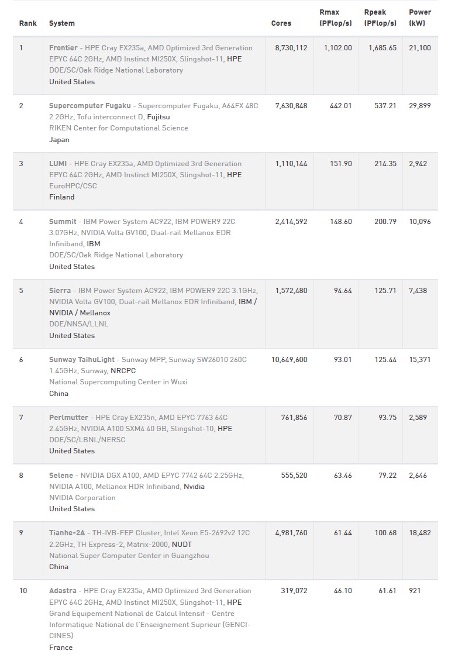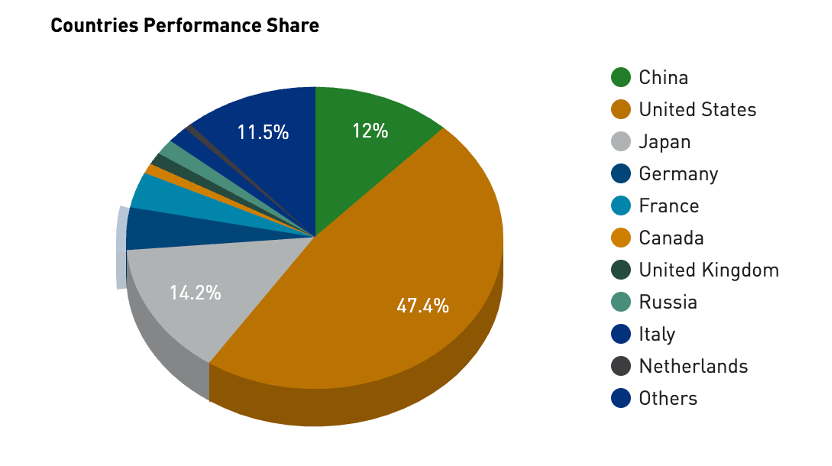
 The world's first public exascale supercomputer, Frontier, the Oak Ridge National Laboratory supercomputer in the United States, has beaten Japan's Fugaku, which has dominated the list for two years, to become the new leader.
The world's first public exascale supercomputer, Frontier, the Oak Ridge National Laboratory supercomputer in the United States, has beaten Japan's Fugaku, which has dominated the list for two years, to become the new leader.  On May 30, local time, the 59th supercomputer Top500 list announced at the ISC 2022 International Supercomputing Conference showed that the US "Frontier" won the first place with obvious advantages, and the "Fuyue" of the RIKEN Computing Science Center in Japan fell to the second place. The third is "LUMI" of CSC data center in Finland.
On May 30, local time, the 59th supercomputer Top500 list announced at the ISC 2022 International Supercomputing Conference showed that the US "Frontier" won the first place with obvious advantages, and the "Fuyue" of the RIKEN Computing Science Center in Japan fell to the second place. The third is "LUMI" of CSC data center in Finland.  The uninitiated can roughly interpret the Top500 list as "a list of the 500 fastest supercomputers in the world" (for those supercomputers that submitted their results for ranking). Frontier is the most powerful supercomputer ever, the first supercomputer to score 1.102 Exaflop/s in the HPL benchmark, truly surpassing the 1 exaflop (E-class) threshold.
The uninitiated can roughly interpret the Top500 list as "a list of the 500 fastest supercomputers in the world" (for those supercomputers that submitted their results for ranking). Frontier is the most powerful supercomputer ever, the first supercomputer to score 1.102 Exaflop/s in the HPL benchmark, truly surpassing the 1 exaflop (E-class) threshold."Although Fuyue's theoretical peak is in fact higher than an exaflop, there are reasons to call the system an 'exascale machine'. However, Frontier is the only system that can prove this on the HPL benchmark." Top500 list organizer wrote.
For the 1.102 Exaflop fraction, Oak Ridge National Laboratory director Thomas Zacharia said at a media pre-briefing, "0.1 can't be discounted either, each 0.1 represents 100 PFlops, it's easy to round up without thinking about it, but every decimal point is Represents great power."
What does the strongest supercomputer of all time mean? Even if you add up the computing power of the next seven supercomputers, it is still not as good as a Frontier (8730112 cores). The second place, Fuyue, achieved an HPL benchmark score of 442 PFlops with 7,630,848 cores, not more than half of that of Frontier; the third place, LUMI, achieved 151.9 Pflop/s with 1,110,144 cores.

The first-place Frontier, the third-place LUMI and the tenth-place Adastra are all based on HPE's all-AMD Cray EX platform, using the third-generation Epyc CPU and Instinct GPU, which seems to show a certain technological trend.
Although Frontier beat Fuyue to reach exascale status in HPL benchmark scores, many people expected the efficiency-oriented Fuyue to maintain its ranking in environmental protection. But Frontier became not only the most powerful supercomputer known, but also the greenest. At 52.23 gigaflops per watt, the system's test machine, the Crusher, also outperformed Japan's Preferred Networks MN-3 system, leading the Green500.

"The fact that the fastest machine in the world is also the most energy-efficient is simply amazing," ORNL laboratory director Thomas Zacharia said in a news release.
In recent years, many people believe that the United States' capabilities in supercomputing are gradually weakening, but in this Top500 list, the United States occupies the first, fourth, fifth, seventh and eighth places in the top ten. .
The two Chinese supercomputers that entered the top ten are: Sunway TaihuLight (93 Pflop/s) ranked sixth, and Tianhe-2 ranked ninth with 61.4 Pflop/s.

In general, in terms of the number of supercomputed units on the list, China still ranks first with 173 units accounting for 34.6% of the total. The United States fell from 150 units in the previous period to 127 units, accounting for 25.4%. Two countries, China and the United States, account for 60% of the total number of TOP 500 lists. Japan, Germany and France ranked the top five with 34, 31 and 22 units respectively.
 In the total performance rankings, the United States accounts for 47.3% of the total computing power, occupying the first place with a large advantage. Japan ranks second with 14.3%, and China ranks third with 12%.
In the total performance rankings, the United States accounts for 47.3% of the total computing power, occupying the first place with a large advantage. Japan ranks second with 14.3%, and China ranks third with 12%.Related Posts
0 Comments
Write A Comments